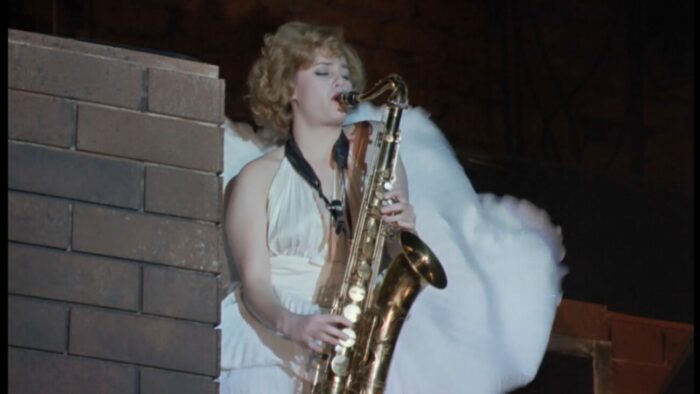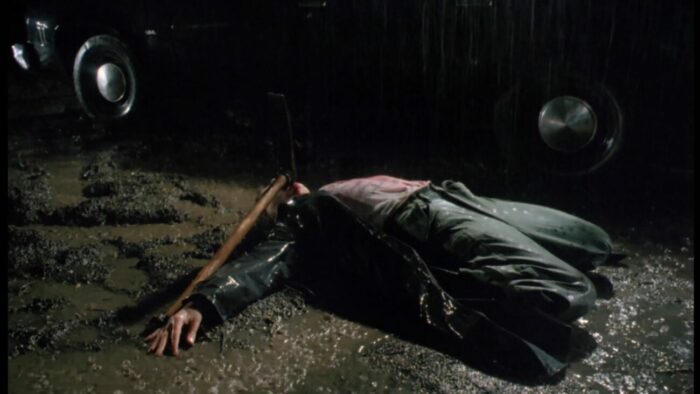One of the things I’ve enjoyed so much about Slasher Saturdays is how I was able to talk about a couple of slashers I really liked, and then switch to ones that have been on my list for a while. Talking about films already familiar to me was a bit of a crutch to get me in the swing of this column—now it’s time for Act II. From here on out, my plan will be to cover slasher films I have never seen before, with a couple of exceptions. Opera was probably the best film to break the mold on for me, so it just made sense to continue the theme of giallos in July, or Gial-ly, a term I’ve seen a few people throw around. A film that’s been on my list for quite some time is Michele Soavi’s 1987 debut feature film Stage Fright. (Yes, he did direct Dario Argento’s World of Horror, so I am referring to his debut narrative feature.)

Stage Fright brings us a story about a troupe of stage actors three weeks out from the opening night of their possibly groundbreaking avant-garde stage play. During rehearsal, Alicia (Barbara Cupisti) sprains her ankle, prompting Betty (Ulrike Schwerk) to take her to the nearest hospital for assistance. The only issue is, the hospital turns out to be a psychiatric hospital. When Alicia and Betty get to the hospital, they ask the attending doctor about one of the patients, who turns out to be actor-turned-mass-murderer Irving Wallace (Clain Parker). Wallace is awoken by Alicia and Betty and makes his escape in the back of their car. After arriving back at the theater, Irving Wallace plans to enact his revenge on the unsuspecting troupe of actors. Will the acting troup survive the night? Or will this be their final curtain call?
After working with Dario Argento on a few films in various assistant director roles, Soavi took the “I didn’t go to film school, I went to film,” approach, similar to Jennifer Kent with her Lars Von Trier mentorship. Honestly, working under Argento is really the only film school you would ever need. Written by Lew Cooper and Sheila Goldberg, Stage Fright was an ambitious idea set on the shoulders of a first-time narrative director. While Stage Fright finds itself on many “top underrated slashers” lists, it is far from perfect. One of the things I think people appreciate most about this film is how Soavi took the lessons he learned from Argento and found a way to bring his own style, while still being able to keep a gritty giallo feel to the film.

Soavi’s direction, substance-wise, is fairly inconsistent, while his direction stylistically is incredibly impressive. For a first-time director, being able to consistently carry a style throughout the film is fairly impressive—especially when it is a film as chaotic as Stage Fright. The biggest downfall of this film is Alicia, regarding both her character and her direction. Cupisti is a fine actor, and with what she was given to work with, I think she did solid. Alicia lacks any real agency or charisma for the majority of the film, which makes her turn from damsel in distress to hero feel a bit far-fetched. In the scenes with Alicia as the focal point, she somehow fades into obscurity, drowned out by the bombastic characters surrounding her. If that was the point, then either Cooper and Goldberg’s script failed to portray that, or Soavi’s lack of directing experience served as a detriment. I was fulfilled by the end of the film, and even with my complaints about her character, I think I would have enjoyed it a lot less if it ended differently.
The real powerhouse acting performance is from stage director Peter (David Brandon). Peter is an incredibly flawed artiste, with a temper shorter than Yosemite Sam. When they find Betty murdered, Peter decides they will push up the date of opening night, hoping to cash in on the media coverage the murder brought to the theater. Symmetrically handsome, and unwarrantedly conceited, Peter has the most interesting character arc. It almost feels like he was initially written as the main character, but David Brandon was never told of the change. From unabashedly chewing the scenery to flipping emotions at the rate of Dennis Reynolds, Brandon’s portrayal of Peter is an absolute riot to watch. Peter starts the film as a “take no prisoners” type of director, and it almost feels like a commentary on Stanley Kubrick. Due to care of the craft over the health and safety of his cast, Peter fires Alicia when she returns from the doctor’s office. Once they are all trapped inside the theater, Peter almost has a change of heart and turns into somewhat of a stoic savior. But when it finally comes down to literal life or death, Peter sacrifices one of his actors so he can get away safely. Spoiler alert, he still dies. The emotional whiplash Peter gives us singlehandedly makes this film worth it.

As with films of this ilk, the kills get generally more graphic as they go. But where the true terror comes in is with the killer’s costume. The antagonist of the stage play is a man in a black suit donning an oversized owl head. What makes it so scary is how comically large and impractical it is, which to me makes Irving Wallace feel undeniably confident in his ability to slaughter the actors even with this crutch. I do kind of wish we had more stage-related kills, as we don’t really have too many play-based horror films. Like a sandbag squashing a head, or a stage light falling and…squashing a head. I think the film would have been a bit stronger if they used the setting more towards the horror, rather than just letting it be a backdrop. What we do get is a great pickaxe kill, someone gets ripped in half, and we even get a great chainsaw kill!
What sets Stage Fright apart from other giallo films is something I haven’t really seen done that often: we get a face and a name to the killer from the very beginning. No mysterious black-gloved man lurking in the shadows, no mystery as to who, or what, the characters are dealing with. It’s Irving Wallace from the beginning, take it or leave it. It’s a little refreshing because the identity of the killer doesn’t really matter here. The story isn’t about trying to find out why this is all going on. We know who it is, so that means you don’t have to worry about trying to give meaning to anything, you just get to sit back and watch a troupe of actors try to survive until sunrise. I can understand how that would be a con for some viewers, but this film doesn’t really feel like it’s trying to say anything important, so you can just get your bowl of popcorn and enjoy the ride.

Stage Fright was an enjoyable surprise. Stylistically, it stands out from the crowd of other giallo and slasher films. Michele Soavi kind of reminds me of Tarantino in a way. While Tarantino steals from other films (I should mention I love Tarantino), you can feel the style and find ways to appreciate the homages he throws in his films. Soavi takes what I like about Argento, who is in my top five favorite Italian horror directors list, and brings a new light to it. Argento eventually seemed to get stuck in his ways, so to see this Argento style through the lens of a bright new filmmaker was incredibly fun to watch. Walking away from this film I couldn’t help but think of one thing: I wish there were more stage-based horror films!




